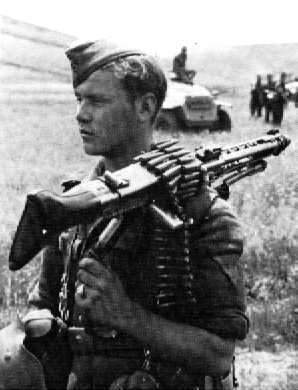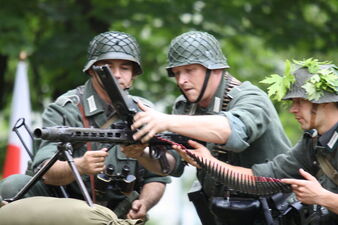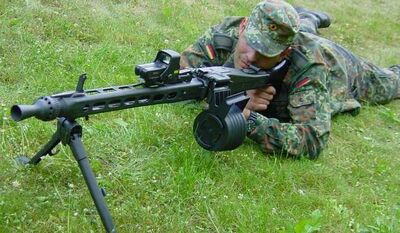The MG42 (Abbreviation of German: Maschinengewehr 42) Is a gun chambered in Mauser 7.92x57mm developed during the WWII by Germany with the intention of replacing the MG-34 With the manufacturing process simpler. His baptism of fire occurred in USSR and North Africa, Being a complete success. It was expected that she would replace the MG-34, but ended up supplementing it by not achieving the expected level of production. During the campaign of the FEB in Italy, the MG42 was nicknamed "Lurdinha" by GI's in Brazil du

A German soldier with a MG-42
e to the rapid rate of fire, reminiscent of the way to talk to the bride's jealous of one of them.
In 1958 we developed a version of the MG42 for 7.62 mm ammunition, adopted as a standard by NATO. The new version was called MG42/59 or MG1, Giving rise to variants MG2 and MG3
History[]
With adoption of the MG-34 machine gun the Wehrmacht had the weapon that was envisaged some 20 years before, and the MG 34 bears the distinction of being the first practical universal (or general purpose) machine gun. While the MG-34 was good and practical, it was certainly not ideal. German experts wanted their machine guns to fire faster, while being simpler and less costly. A high rate of fire was desirable both for AA applications and for surprise flanking fire against targets moving through the battlefield. As early as 1937 HWaA issued a request for the next new universal machine gun,and three companies received development contracts – Johannes Grossfuss AG, Stubgen AG and Rheinmetall-Borsig AG. In 1939 a commission selected the Grossfuss-made MG 39 prototype for further development. Designed by engineer Gruner (often wrongfully referred to as Grunow) and small arms designer Horn, new weapon, in accordance with HWaA request, had a stamped steel construction, combined with locked breech, short recoil action. Initial trials suggested that the Grossfuss MG needed further development, and in late 1941 a small batch (about 1500 pieces) of improved guns was manufactured for troop trials as the MG 39/41. The new machine gun, while being made to lower standards of fit and finish, proved to be quite functional and reliable (a feature that the much more “refined” MG-34 lacked, especially in the mud and snow of the Russian front). Subsequently, it was officially adopted as the MG-42, and production commenced later the same year. In general terms, the MG-42 was a great success. It fulfilled the roles of a light machine gun on a bipod, a medium machine gun (on a newly developed Lafette 42 tripod), and an anti-aircraft machine gun, mounted in single and twin installations, ground and vehicle-mounted. It was relatively inexpensive to make and required less raw materials than the MG-34, and it was simple to maintain and use. On the minus side, it had a somewhat excessive rate of fire, usually quoted as 1200 rounds per minute, although German WWII era manuals listed it as 1500 rounds per minute (25 rounds per second). This rate of fire resulted in excessive consumption of ammunition and rapid overheating. While the extremely rapid barrel change procedure allowed for sustained fire, the resulting accuracy left something to be desired; excessive vibration from recoil, combined with a short sight radius, resulted in degraded long range accuracy compared with earlier MG-34 and, especially, the heavy Maxim MG-08 guns. Nonetheless the MG-42 was an impressive and fearsome weapon, known among Allied soldiers as “Hitler’s saw”, for the sound of the firing which resembled the sound of a giant mechanical saw.

Soldiers reloading a MG-42
After the WWII this weapon, unlike other wartime designs, lived on, as in 1958, the FRG (West Germany) re-instituted its official armed force, known as the Bundeswehr. Since the core of the Bundeswehr was formed of WWII veterans, it was logical to adopt weapons which were already proven and familiar to the troops; and the MG-42 was one of such weapons. It was, obviously, chambered for a ‘non-NATO’ cartridge, but this was only a minor issue, as the 7.62x51 NATO and 7.92x57 Mauser shared the same cartridge base diameter, and were somewhat similar in ballistics. The real problem, however, was that Germany had lost most manufacturing facilities for the MG-42, so the newly reestablished Rheinmetall concern had to install production facilities from the ground up. The production documentation for original MG-42 machine guns was obtained from Grossfuss company and transferred to Rheinmetall (German government had to pay significant royalties to Johannes Grossfuss for manufacturing rights). Since the preparation for manufacture took some time, the FRG purchased some ex-Wehrmacht MG-42 weapons from other countries. Those guns were converted to 7.62 NATO by Rheinmetall and officially designated MG-2. The newly produced MG-1 guns went through a number of modifications, which resulted in the definitive MG-3 version, which still is rather close in design to the war-time MG-42, although made to much higher standards of fit and finish. The simplicity, low manufacturing cost and high effectiveness of the MG 3 attracted several other countries, which either bought the guns from Rheinmetall (such as Denmark), or obtained manufacturing licenses and build (or at least have built in the past) the same guns domestically (such as Italy, Iran, Turkey, Pakistan and Yugoslavia). In total, at least twenty armies have used or still are using the MG-3 and its versions. It must be noted that in some countries these guns were used under their "commercial" Rheinmetall designation MG 42/59.
The MG-42 is a short-recoil operated, air cooled, belt fed weapon which fires from an open bolt. The barrel is quick-removable, and can be replaced in less than six seconds by a properly trained crew, although an asbestos glove is required to remove the hot barrel. The action of the weapon is operated by the recoil of the locked barrel, assisted by a muzzle booster which uses pressure from the muzzle blast to increase the recoil impulse. Locking is achieved by a pair of rollers, which are forced outwards from the sides of the bolt head to engage cuts in the barrel extension. Locking (outward) movement of the rollers is controlled by the wedge-shaped front part of the bolt body; unlocking (inward) movement of the rollers by the cams made in the receiver. This is a simple and solid system which minimizes the length of parts that are under stress upon discharge, and also minimizes the strain on the receiver. On MG 3 machine guns, two types of bolts are available, with standard weight (about 650 gram) for fast rate of fire and with heavy weight (about 900 gram) for slow rate of fire. It must be noted that those bolts also are used along with different return springs.
The receiver and barrel jacket are made in one unit, and formed from a sheet of rolled steel, cut to shape by pressing and stamping, and then welded and pinned to form a gun housing of generally rectangular cross-section. The front part of the housing serves as a barrel jacket and has a number of oval cooling slots at all sides except the right. The right side of the jacket has one long slot which is used to remove the barrel. The barrel is held in place by a hinged lock, located at the rear of the opening in the right side of the jacket. To remove the barrel, the operator must first lock the bolt in the open position (cock the weapon), and then turn the barrel lock to the right and forward. This will release the barrel and bring its breech area out of the jacket, so it can be grabbed (using the issued asbestos glove or other heat insulation means if the barrel is hot) and pulled back and

Fallschirmjäger defend the ruins of Monte Cassino. Well entrenched, the Germans inflicted heavy casualties on the assaulting Allied forces.
out of the jacket. The new barrel is then inserted all the way forward and lock then is snapped into place, bringing the barrel into alignment with the action.
The gun is fed using belts only. Feed direction is from the left to right; the feed is of the one-stage, push-through type. The belt is same as for the MG-34, with steel links with open pockets, assembled into non-disintegrating 50-round lengths. The same MG-34 type “Gurttrommel” 50-round drum-type belt containers can be used with the MG-42, and a new type of lightweight plastic 50-round belt container was developed in West Germany by HK and is now issued with MG-3 guns. The belt feed is operated by the reciprocating bolt which has a roller at the top of its body. This roller engages the cam track in the oscillating lever, located in the top-opening feed cover. The lever operates the belt pawls in two steps, on both opening and closing movement of the bolt, resulting in a smooth and positive feed. This two-step belt traction is particularly useful because the high rate of fire results in high-speed belt movement, and this system reduces the strain put on both the feed unit and belt links. Current production MG-3 guns can fire either non-disintegrating or disintegrating belts. The trigger unit is of relatively simple design, and permits for automatic fire only. The manual safety is of the cross-bolt, push button type, located at the top of the pistol grip. The charging handle is located at the right side of the receiver, and is separated from the bolt group (it does not move when gun is fired). Each MG-42 was issued with an integral, adjustable bipod attached near the muzzle; MG-3 guns may have two points for bipod attachment, one near muzzle and another near the center of the gun. In the medium role, the MG-42 was used from the Lafette 42, a complicated foldable tripod with buffered cradle. A wide number of tripods is available for MG-3 guns, as produced in several countries. The standard sights are open, fully adjustable, and mounted on folding bases. The universal tripod has provisions for mounting telescopic sights for long range and indirect fire missions.
Variants[]
- MG39: Prototype developed in 1939 from the MG-34;

German soldier aiming the MG3, fitted with EOTech holosight red-dot optics and a 50-round plastic belt container (which appears to be empty)
- MG42: Reassignment of MG39, entering the service of the German Army in 1942;
- MG42V (Or MG45): Experimental variant of the MG42 with a different operating mechanism and using lower-quality metal in order to compensate for the lack of materials;
- MG42/59 (Or MG1) Variant developed by Rheinmetall MG42, with a new camera to use the 7.62x51mm NATO ammunition;
- MG1A1: As MG1, but with the sights calibrated for the new ammunition. Most existing MG1 were transformed in this version;
- MG1A2: Variant of enhanced MG1A1;
- MG1A3: Variant of enhanced MG1A2;
- MG1A4: Variant adapted for fixed mounted on armored vehicles;
- MG1A5: Variant resulting from the conversion of the standard MG1A3 MG1A4;
- MG2: Name given to the former MG42 converted to use the ammunition 7.62 x 51 mm NATO;
- MG3: Variant of MG1A3 with crosshairs installed AA;
- MG3E: Experimental MG3 variant with a reduced weight of 1.3 kg;
- MG3A1: MG3 variant to use fixed mounted on armored vehicles.
- Steyr MG-74: Variant made by the Steyr and the Beretta to the Austrian Army.
- Mauser MG-81: A anti-aircraft variant based on the MG-42
Operators[]
- Germany
- Canada
- Denmark
- Estonia
- Greece (produced under license)
- Iceland
- Italy (produced under license)

A German SS Landser involved in heavy fighting in and around the French town of Caen during the summer of 1944. He is carrying an MG 42 configured as a light support weapon with a folding bipod and detachable drum magazine.
- Lithuania
- Norway
- Portugal
- Spain
- Poland
- Turkey (produced under license)
Outside of NATO:
- Saudi Arabia
- Australia
- Chile
- Cyprus
- Finland
- Iran (produced under license)
- Malta
- Myanmar (produced under license)
- Pakistan (produced under license)
- Sudan (produced under license)
- Sweden
- Switzerland
- Thailand
Specifications[]
| Caliber |
|
| Rate of Fire | 1,200 RPM |
| Output velocity of the projectile | 755 m / s |
| Effective range | 1000 m |
| Weight | 11.57 kg (unloaded) |
| Overall length | 1220 mm |
| Food | tape ammunition |
| Variants |
|
See also[]
- MG-34
- Rheinmetall MG-3
- Browning M-1919
The original article can be found at Grossfuss MG-42 and the edit history here.

